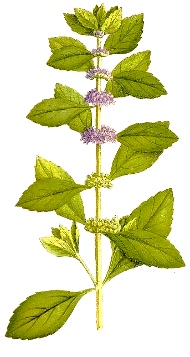 Mentha arvensis
Mentha arvensisWild mint
This mint has more of a camphorous, high, cold scent than the domesticated varieties like spearmint and is nowhere near as sweet; it is in fact the major source of natural menthol. Because of that, it doesn't have the same sort of foodie or emotional associations as the other mints, which can be a real advantage in scentwork. It grows in a necklace around the Pole in the Northern Hemisphere, which makes it perhaps a bit more transcultural than other mints as well. Mints are often ruled by Venus, and we see this even in wild mint's historical use in Cheyenne love magic (they chewed the leaves, carried them, or made a tea of this herb for attacting love), but this mint has a lot of Air to it on account of it not being sweet like other mints and its history as a treatment for lung-related ailments. That doesn't stop it from being protective. Mice and rats hate it, which makes it a great strewing herb (and it has likewise been added to grain bins to help keep out varmints) but also indicates how helpful it would be at keeping less material vermin out, like obnoxious spirits, especially because this is an Air herb. Consider it as an ingredient in spiritually protective potpourri, for example. Wild mint has had plenty of mundane uses as well. The Cheyenne made a tea to treat various complaints from wild mint, macerated it in oil to make a hair dressing (a neat idea), and used it as a potpourri. Various tribes drank wild mint tea as a treatment for colds and stomach complaints or sprinkled the dried herb on food, their floors, or their bedding as a non-toxic bug repellent. The Paiute drank the tea as an aid in keeping cool. The Sioux used it in hunting to hide the scent of humans. Thompson Indians added it to pillows to freshen them. Also known as cornmint, brook mint, and field mint.
How to Grow Wild Mint
Like many plants with very small seeds, wild mint is surface sown. That means that you first get your planting medium wet, preferably with a soaking of a dilution of liquid kelp, and then sprinkle the seeds over the surface, gently tamping them in with your fingertip. Some sources insist that you have to keep surface-sown seeds under a plastic cover, but you just want to make sure they don't dry out, or they will be killed. You can simply mist such plantings every morning and bottom-water once they sprout. Transplant seedlings out to full sun/light shade. It prefers moist areas but will grow in drier soil than most other mints. It gets up to 1.5-2ft/.5m tall and up to 3ft/1m wide but more commonly 1ft/30cm. Small bees, wasps, and small butterflies get nectar from the flowers. This is a perennial that grows not only from seeds but from runners underground, so don't plant it where it's not okay for it to spread. Wild mint is a good companion planting for brassicas and tomatoes, repelling bugs. Deer generally don't eat this plant; it gives ruminants indigestion, although it is fine for us scavenger types. The flowers of this particular subspecies harvested from the wild are usually white instead of violet, as in the picture--there's a lot of variability with mints, especially this one. It begins blooming in July; Harvest leaves as the flowers begin to show.
Mentha arvensis
Wild Mint
100 seeds $3.50
Uses in Witchcraft & Magic:
Spiritual Protection
Love Spells
Venus/Air Herb
© 2013-2024 Alchemy Works; No reproduction without permission